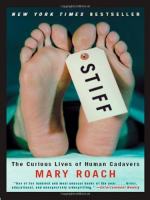
|
| Name: _________________________ | Period: ___________________ |
This test consists of 15 multiple choice questions and 5 short answer questions.
Multiple Choice Questions
1. What did Frederick Zugibe test?
(a) The ability of the wrist or hand to support a person's weight.
(b) The ability of crucified people to move.
(c) The stains a crucified person will make on a shroud.
(d) The chemistry of the Shroud of Turin.
2. What almost prevented cremation from getting off the ground?
(a) Ties to Catholicism.
(b) The sense of secularism.
(c) Laws governing disposal of human remains.
(d) The personalities of the people who ran it.
3. Who ended the belief in severed head consciousness?
(a) George Martin.
(b) Legallois.
(c) Brown-Sequard.
(d) Dr. Joseph Ignace Guillotin.
4. What is a mellified man used for?
(a) Spiritual uses.
(b) Gastric disorders.
(c) Topical application for wounded limbs.
(d) Acne.
5. What did father Armaillhac want to prove about the Shroud of Turin?
(a) That it was not the burial cloth of Christ.
(b) That it was of recent origin.
(c) That it was a forgery.
(d) That it was the burial cloth of Christ.
6. What was the original advantage of cremation when it was first advocated?
(a) Cheaper.
(b) Sterile.
(c) Less pollution.
(d) More efficient.
7. What kind of mummies were sold in 18th century Alexandria?
(a) Recent.
(b) Counterfeit.
(c) Ancient.
(d) Syrian.
8. When did McDougal perform his experiments?
(a) 1850.
(b) 1826.
(c) 1907.
(d) 1980.
9. How does Mary Roach characterize the brain?
(a) As the location of the soul.
(b) As the heart of the soul.
(c) As the seat of consciousness.
(d) As the last thing to die.
10. What are brains in brain banks kept in?
(a) Formaldehyde.
(b) Acetone.
(c) Plastic.
(d) Freezer bags.
11. What did Dr. Pierre Barbet focus on in the Shroud?
(a) A figure in the cloth.
(b) A hole.
(c) Symbols in the stains.
(d) A split flow of blood.
12. How did Barbet test his skepticism?
(a) He crucified monkeys and other animals.
(b) He strapped volunteers to crosses to see how much movement they could make.
(c) He attached weights to amputated arms to see how much a nail could hold.
(d) He performed a chemical analysis of the Shroud of Turin.
13. What ingredient is used in water reduction?
(a) Oxygen.
(b) Acid.
(c) Polymers.
(d) Lye.
14. What does Hugh Patterson of UCSF say about having arranged to donate his body to science?
(a) He will keep teaching in death.
(b) He will extend his contribution to humanity a little longer.
(c) He will get the most mileage out of his body.
(d) He will live in more people's memories.
15. Which mummies were supposed to be best?
(a) Bodies that died suddenly.
(b) Bodies that died peacefully.
(c) Bodies that died violently.
(d) Bodies of philosopher kings.
Short Answer Questions
1. When were mummies used medicinally?
2. What did Brown-Sequard's test of Legallois' notion appear to show?
3. What sign ultimately showed doctors and families that a person was dead?
4. What did Mary Roach struggle with when she saw H?
5. How does Mary Roach describe the possibility of testing for consciousness in severed heads?
|
This section contains 531 words (approx. 2 pages at 300 words per page) |

|




